One major mistake many people make when baking pies is having their pie crusts stick to the pan. As such, the pie becomes difficult to remove from the pan without crumbling, spoiling its appearance. If you want a perfect pie, you have to ensure that your pie easily comes out of the pan.
This article will cover
- What Makes A Pie Crust Stick To The Pan?
- How To Keep Your Pie Crust From Sticking To The Pan?
- How To Bake The Perfect Pie?
- How To Clean Burnt Pie Crust From The Pan?
What Makes A Pie Crust Stick To The Pan?
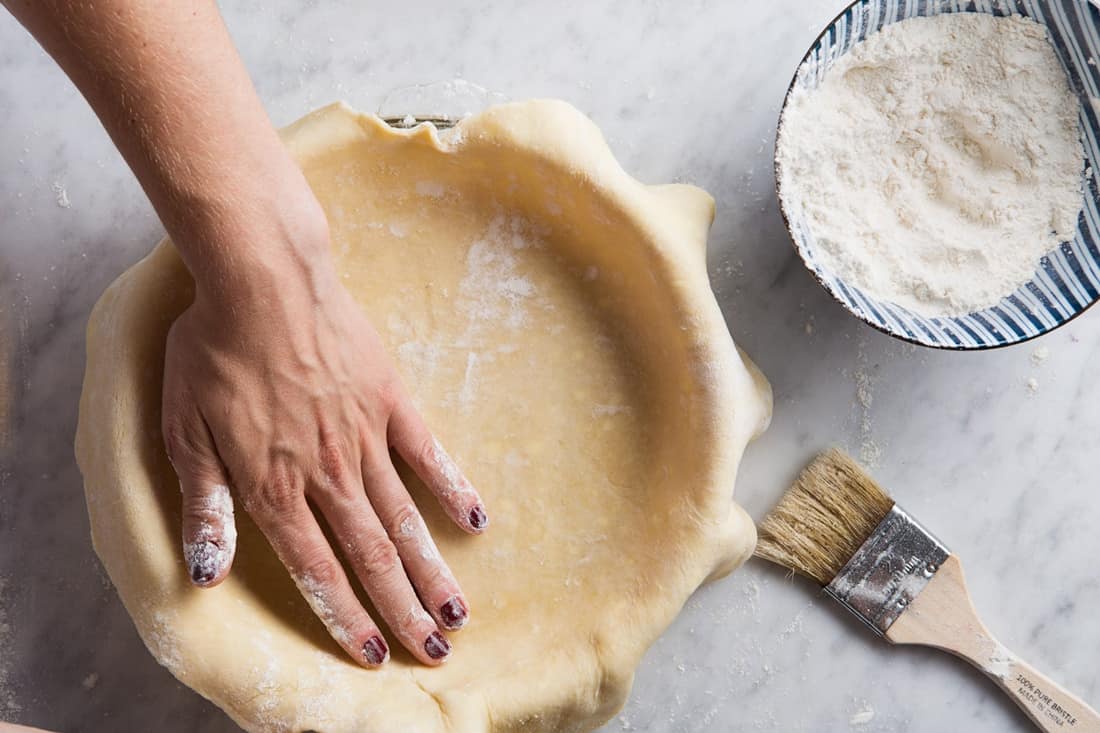
To prevent your pie from sticking to the pan, you need to know what makes a pie crust sticky in the first place. This will help you know how best to work around the situation when it happens.
Not using the right cookware
The type of pan you use determines how well your pie crust will turn out. The best cookware for baking pies is glass pie dishes because of their excellent heat conductivity and distribution. Also, they bake your pies evenly.
Due to their transparency, you can always see when the pie is done. You don’t need to grease glass pie plates before you use them. However, if you use sticky cookware like a stainless steel pan, there is a high chance of your pie crust sticking to the pan’s bottom. And you shouldn’t grease your pie pans as it will change the crust’s texture.
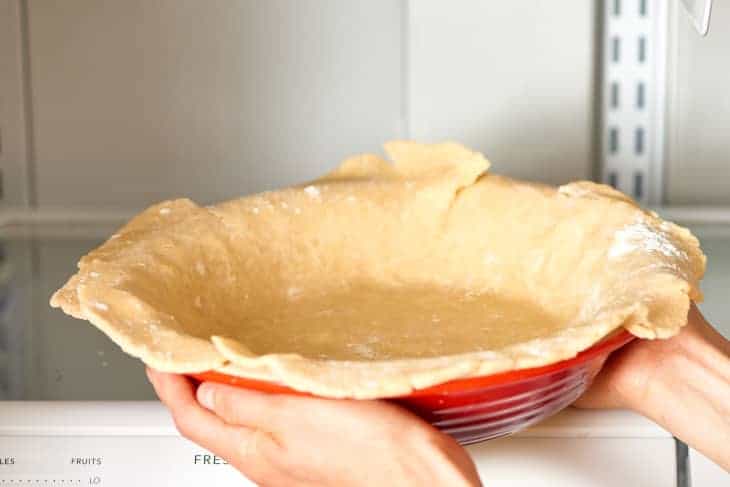
Not lining your pie pans
If you’re using another cookware aside from a glass pie plate, you need to line it with parchment paper. Not lining it will make it difficult to remove the pie when it is done.
Using the wrong ingredients
The wrong ingredients can also make your pie crust stick to the pan’s bottom. For instance, using low-quality flour won’t give you the perfect pie. If the flour doesn’t rise while baking, it will stick to the pan.
To get the best results, use cake flour. Also, ensure the butter you use isn’t soft. The harder it is, the better for your pie crust. Don’t overwork the dough either, as it will become hard to roll. Follow the exact steps in your pie recipe to get the perfect pie dough.
Using a sticky pie dough
Your dough should neither be too moist nor too dry. To know if your dough is too wet, check if it sticks to your rolling pin. If it does, add more flour. However, remember that too much flour will make your dough a cracker. To get the perfect pie crust, you need a dough that is tender and flaky.
How To Keep Your Pie Crust From Sticking To The Pan?
Once you know why your pie crust sticks to the pan, preventing such from happening will be easy. Here is a guide on how to keep your pie crust from sticking to the pan;
Line your pan
Using parchment paper or aluminum foil to line the pan before you place the dough keeps your pie crust from sticking to the pan since there is no direct contact between the pan and the pie. Besides, it’s easier to remove the pie from parchment paper or foil than a pan. You can also use a pan with a removable bottom.
Pre-bake your dough
Pre-baking your dough ensures that your pie crust isn’t soggy at the bottom, thereby not sticking to the pan. It also ensures that your pie gets baked thoroughly, especially if you’re adding a filling that doesn’t need much time to get done. With a firm pie crust bottom, your pie will easily come out of the pan when you want to remove it.
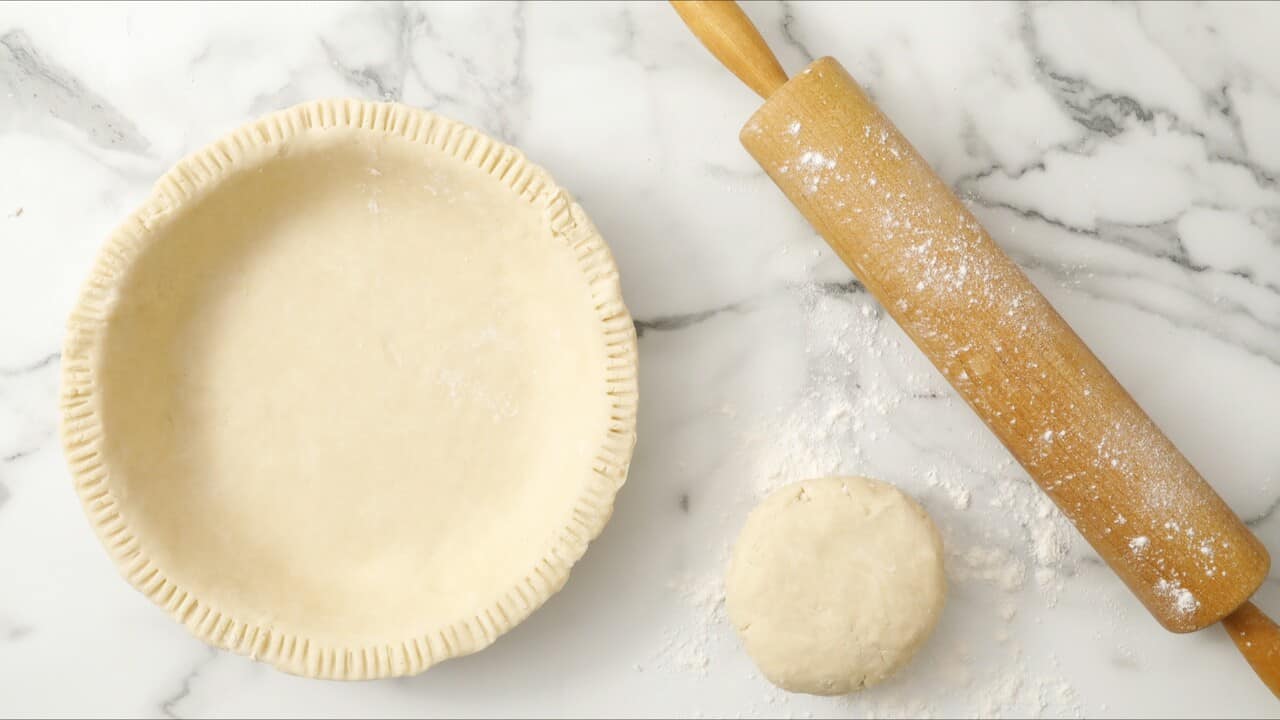
Refrigerate your dough
There are many reasons to refrigerate your pie dough before you bake it. First, refrigerating makes it easy to work the dough. As such, you won’t find it difficult to cut, roll or knead it. Also, it reduces the rate of shrinking in the baking process, which prevents the dough from sinking into the pan’s bottom. Let the dough stay for at least 30 minutes in the fridge before you take it out and start working it.
Patch up any cracks
Cracks also cause your pie crust to stick to the pan. This is because your fillings will likely leak from the cracks and run to the bottom of the pan, making the pie crust soggy and sticky. By the time the pie is done, it’ll be difficult to remove it from the pan.
If there are cracks in your dough, refrigerate it for some minutes and knead it into a ball. Brush the dough with water and seal up the edges. However, don’t use too much water to prevent the dough from becoming too moist.
How To Bake The Perfect Pie?
No one likes to commit time and effort into baking a pie that turns out burnt or with a runny filling. You can bake the perfect pie crust if you pay attention to the details. Here is a guide on how to bake the perfect pies:
Use the proper ingredients in the right proportion
The quality and proportion of the ingredients you use matter too. Usually, the perfect dough should have the right amount of fat, liquid, and flour. Too much flour or a low-quality one will make the dough too dry; too much liquid will make it soggy. A perfect pie starts with a well-made dough. You should use exact measurements to avoid making bad dough.
Keep the edges from burning
If you don’t protect your pie crust’s edges, they will get done before the rest of the pan. As such, they are likely to get burnt or become too brown. To prevent this, wrap the edges in aluminum foil. Only remove in the last lap of the baking process.
Use the lowest oven rack
Always use the lowest oven rack for baking your pies. This ensures that the bottom of the pie crust is firm and keeps the edges from darkening. Preheat your oven before you place the pie in it. This way, the pie crust won’t shrink to the bottom of the pan.
Use the right timing
A perfect pie is neither burnt nor unevenly baked. For your pies to be uniformly and properly done, bake them long enough. However, don’t overdo it, as overbaking causes cracks and loss of moisture in the pie.
The timing depends on the type of pie. For example, fruit pies need more time than custard pies. You can set the alarm on your phone or the oven’s timer to remind you of your pie in the oven.
Let the filling set before serving
Don’t serve your pie the moment you take it out of the oven. If you cut the pie straight away, the filling will run out, and that will be a big mess. Allow the pie to cool before serving. It might seem frustrating waiting for some hours, but you’ll get tidy pie slices at the end.
How To Clean Burnt Pie Crust From The Pan?
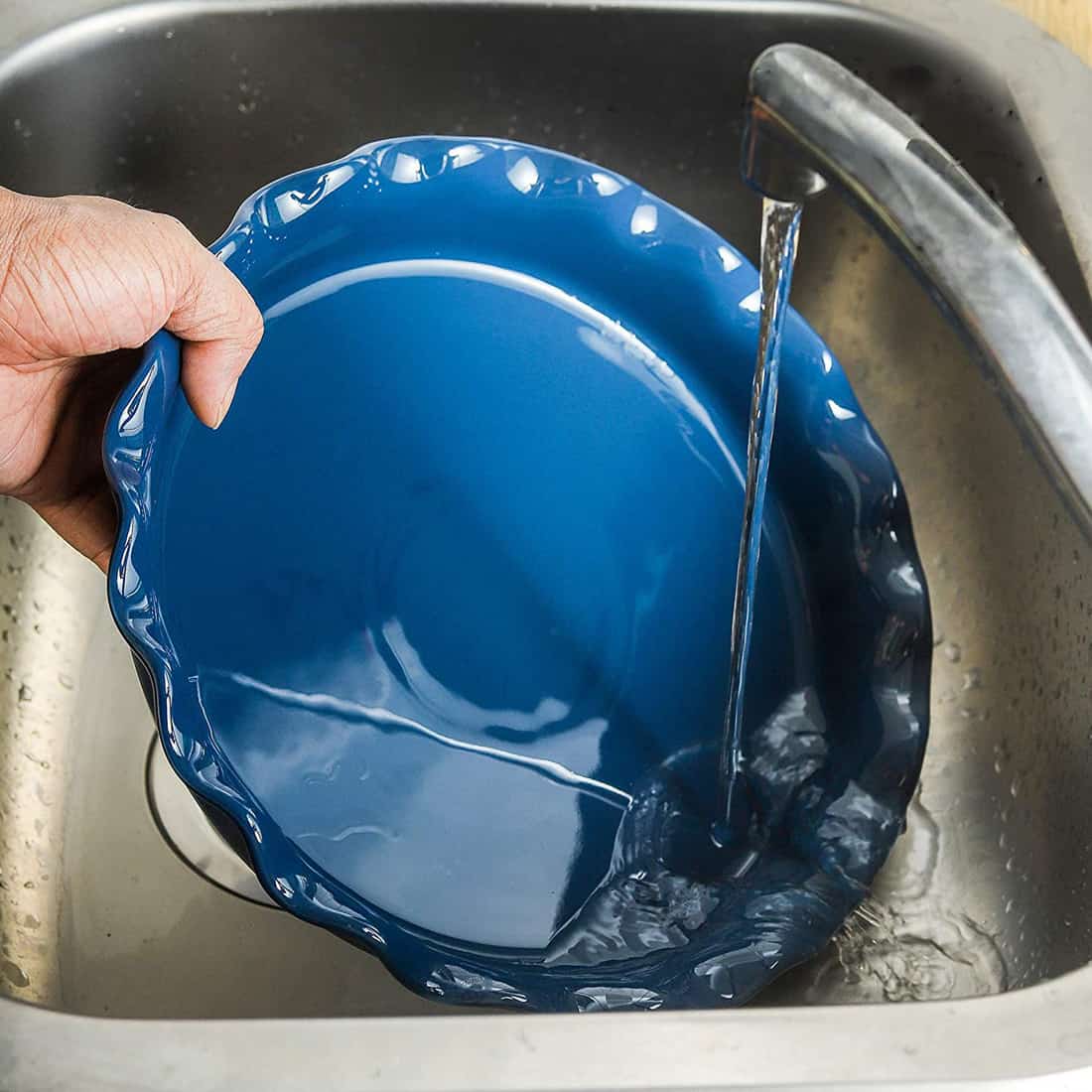
Having a burnt pie crust not only keeps you from having a perfect pie it can also damage the pie pan. If you don’t clean the burnt residue off the pan quickly, it can become a permanent layer on the pan’s surface.
The best thing is to keep your pie crust from burning. You do this by not leaving your pie unattended when baking, not opening the oven door every second to check the pie, lining the pan with aluminum foil, etc. Here are ways you can clean burnt pie crust from your pan;
Remove the pie crust
The damage has been done already, but you can’t leave your pie crust in the pan forever. Once the pie has cooled, use a knife to slice it into different parts. Then, take out the sliced pieces. Use the knife to scrape off parts that need to be scraped off as well. You would have to make do with the pie crumbling, as there are few chances of avoiding this.
Make a solution
A soap and sponge alone can’t get rid of the burnt residue on your pie pan. You need something extra, like a solution. One way to do this is to mix warm water with baking soda and soap.
Pour the solution into the pan and allow it to sit for some minutes before you scrub the pan with soap and water. You can also make a solution of baking soda and vinegar. Boil the mixture in the pan for some minutes.
Clean the pan
Once you’ve poured away the solution, you still have to clean the pan with soap, a non-abrasive pad, and water. The pan will be easier to clean because the solution would have gotten rid of the burnt residues. Rinse the pan well after washing. Ensure there’s no moisture left on the pan before you store it. Also, store the pan in the right place.
Once you’ve cleaned the burnt pie crust from your pan, ensure you keep your pie crust from sticking to it in future uses. Regular burning destroys a pie pan.
Summary
You can ensure a perfect pie by preventing it from sticking to the pan. Using the right cookware, making a good dough, set your oven to the right temperature, etc., are some of the ways to achieve that. If your pie crust sticks to the pan, ensure to get rid of it as soon as possible to protect the pan from damage.
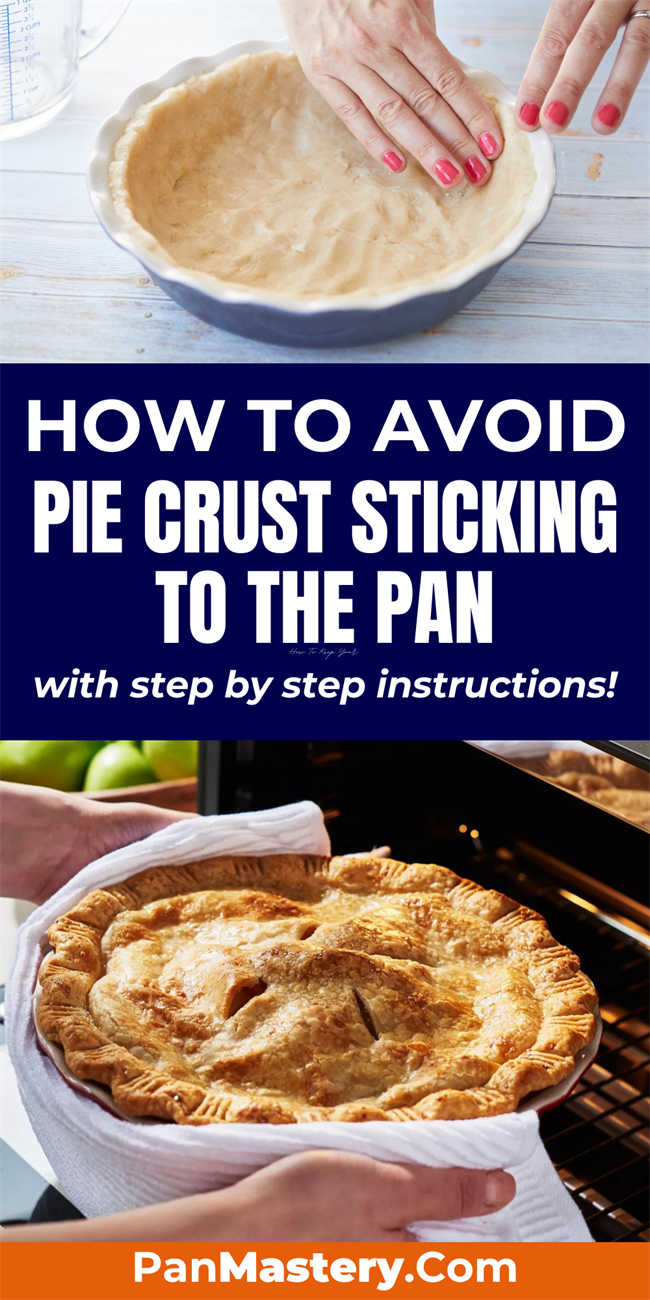

Michael Johnson is the founder of Pan Mastery, Inspired by his blacksmith grandfather’s legacy has a deep appreciation for hand-crafted pots and pans, he provides invaluable guides, reviews, and recipes to enhance your culinary journey.
